The rule of thirds is a powerful compositional device – and can often be the difference between a stunning photo and a boring one.
But what actually is the rule of thirds? How does it work? And should you always apply it in your compositions?
In this article, I’m going to take you through everything you need to know about this compositional “rule.” I’ll explain how you can apply it to different types of photos for great results. And I’ll include plenty of tips, tricks, and helpful pointers.
By the time you’re done, you’ll be creating beautiful compositions like a pro!
Let’s get started.
What Is the Rule of Thirds in Photography?
The rule of thirds is a fundamental compositional guideline. It uses a three-by-three grid to position the important parts of your photo, so that main compositional elements are positioned a third of the way into the frame.
Here’s the rule of thirds grid:
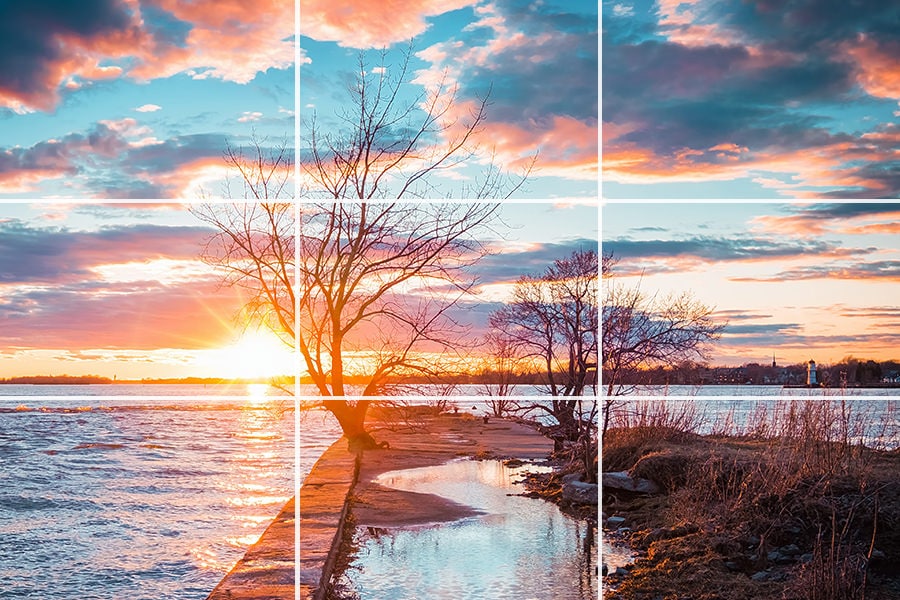
Therefore, to follow the rule of thirds, you generally need to place your horizon along one of the horizontal gridlines. And you generally need to place your main subject(s) at the intersection of horizontal and vertical gridlines (known as power points).
It’s how you can achieve a balanced image such as this one:

With the horizon falling along a horizontal gridline, and the main area of interest perfectly targeted by a power point.
What Is the Origin of the Rule of Thirds?
While the rule of thirds has been used by artists going back at least to the Rennaissance, it was explicitly formulated by a painter, John Thomas Smith, in the late 18th century.
You see, artists realized that too much symmetry in a piece of art led to it becoming “awkwardly suspended” – so that there was no real flow in the composition.
The rule of thirds, on the other hand, advises artists to position their compositional elements with noticeably different proportions within the scene. So instead of painting (or, in our case, photographing) a landscape with half sea and half sky, you put the sea in the bottom third or bottom two thirds of the frame, you put the sky in the top two thirds or top third of the frame, and you got a dynamic, energetic composition!
When the rule of thirds is carefully applied, the viewer observes the piece of art and their eye starts to wander, lingering on different portions of the composition – which is often ideal. Plus, the rule of thirds helps maintain balance in a frame, by offsetting a main subject in one third of the composition with a less eye-catching area in the remaining two thirds of the composition.
It’s important to note, then, that the rule of thirds is not just designed for photography. Artists of all stripes use it, from painters to cinematographers and more.
Why Does the Rule of Thirds Work?
The rule of thirds helps your compositions achieve two things:
Balance.
And flow.
Each of these items on their own may not make for a stunning shot – but taken together, it’s the recipe for a truly great result.
Specifically, the rule of thirds balances your composition by offsetting “heavy” elements in one third of the frame by “light” elements in two thirds of the frame.
Like this:
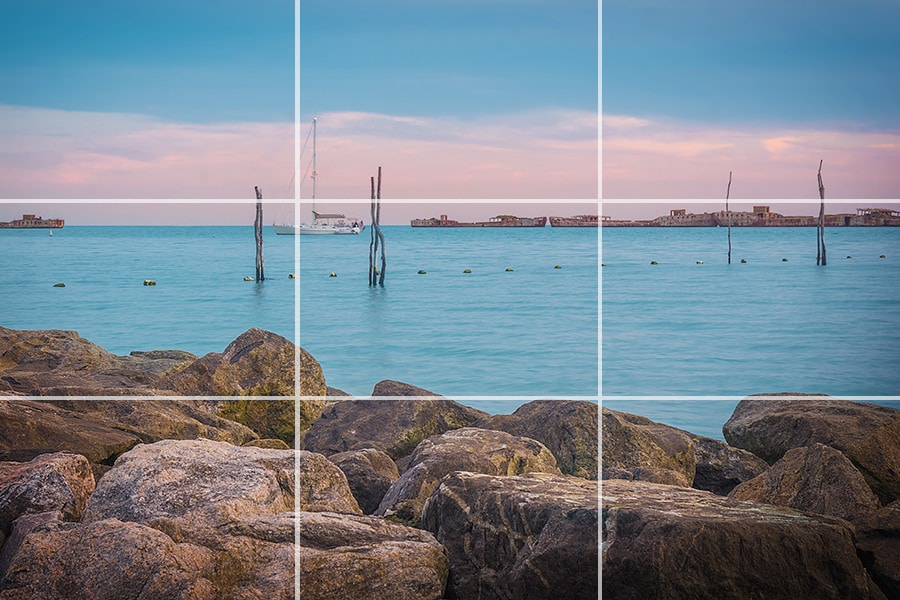
Do you see how the lower portion of the photo stands out – but is carefully balanced by the upper, emptier portion of the photo?
That’s the rule of thirds at work.
As for flow:
By dividing your composition into differently sized sections, the rule of thirds helps guide the eye from element to element, rather than pushing it toward the center of the frame and keeping it there.
That way, the viewer doesn’t get stuck in one place. Instead, they go on a journey throughout the image.
How Can You Use the Rule of Thirds in Portrait Photography?
Portrait photography is a great place to start with the rule of thirds.
Why?
Because you’ll generally have a clear point of interest (a person!), plus a uniform background.
You see, when applying the rule of thirds, I highly recommend you start by recognizing the main subject of your composition.
Then place that main subject along a gridline – and ideally at an intersection point.
In portrait photography, this means putting your portrait subject along a vertical gridline.
And I highly recommend aligning the subject’s head with an upper rule of thirds intersection point.
In fact, if possible, you’ll want to place the subject’s eye precisely under the point of intersection, like this:
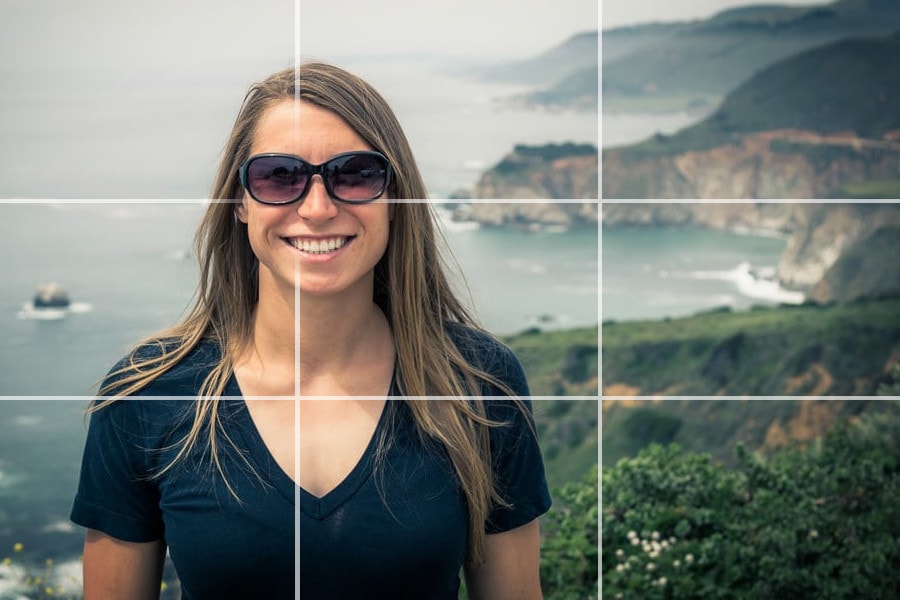
I’d also recommend you bear in mind a corollary to the rule of thirds, often referred to as the rule of space.
Rule of Space
The rule of space states that your subject should have room to look into.
So if your subject is facing slightly left, make sure they’re on the leftmost gridline, with plenty of space on the left side.
And if your subject is facing slightly right, make sure they’re on the rightmost gridline, with plenty of space on the right side.
Following the rule of space will keep your compositions fluid and relaxed (whereas violating the rule of space will often create tense, uncomfortable results).
How to Use the Rule of Thirds in Landscape Photography
In landscape photography, the rule of thirds often relies heavily on your positioning of the horizon line.
After all, most landscape shots have a clear horizon.
And by carefully positioning this along the upper or lower horizontal gridline, you can create a shot that feels both balanced and dynamic, like this:
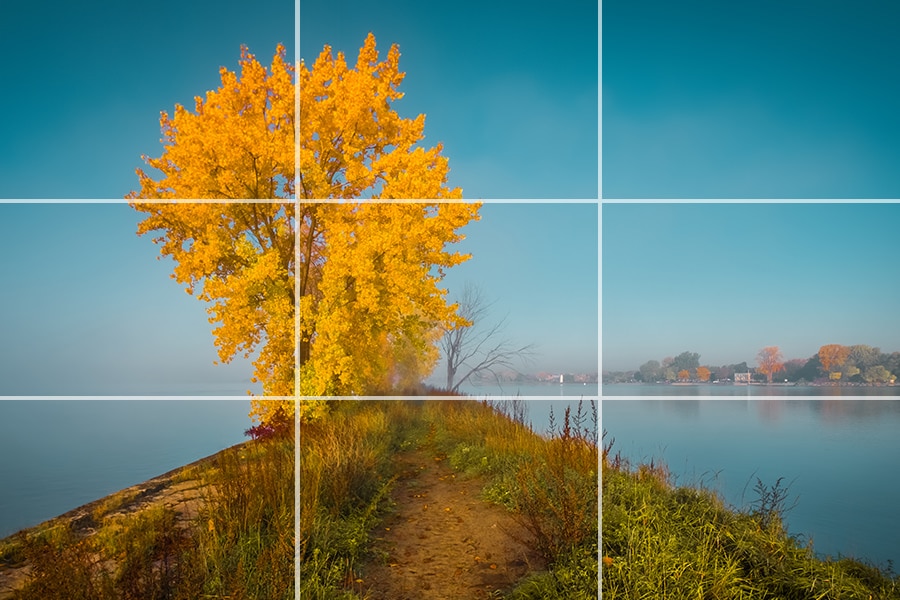
Note that, before applying the rule of thirds, you’ll want to think about the type of scene you’re working with.
When the sky is dramatic and bold, you’ll often want to emphasize it by putting the horizon line on the bottom horizontal gridline.
But when the sky is boring but the foreground offers a lot of interest, you’ll want to do the reverse:
Here the point of interest is the river in the foreground and so the horizon is placed close to the upper horizontal line.
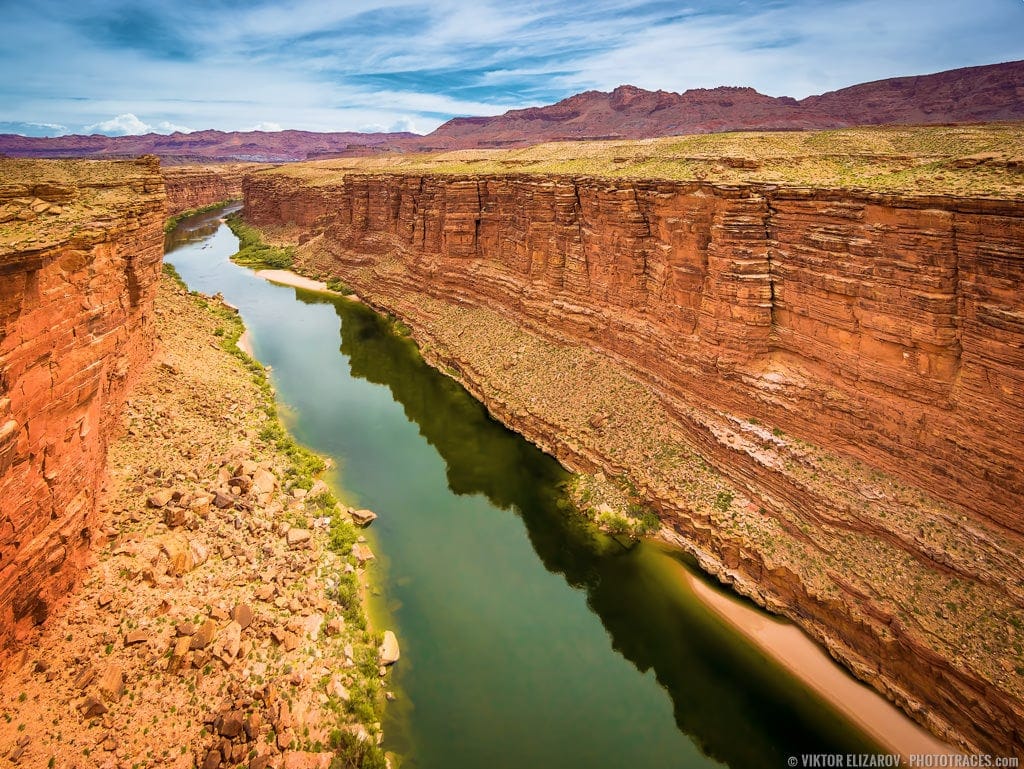
Place the foreground in the bottom two-thirds of the frame, with the horizon line sitting on the upper horizontal gridline.
To be clear:
The rule of thirds in landscape photography doesn’t end with the horizon line. You’ll often want to carefully position eye-catching elements (such as waterfalls or interesting rock formations) along the vertical gridlines, and ideally at intersection points.
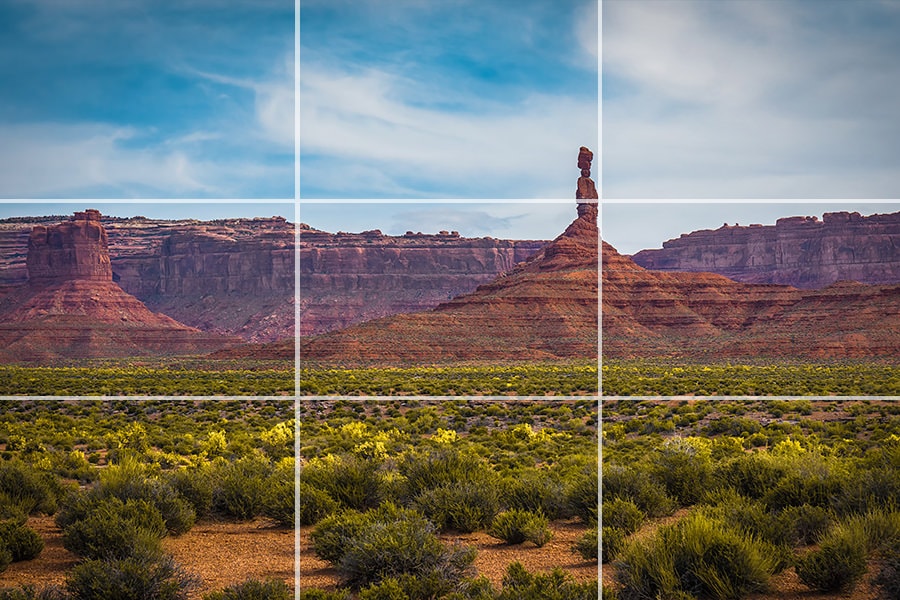
But placing the horizon line is often the first thing you’ll want to do – and it’s a great way to get the compositional ball rolling!
Rule of Thirds Photography Tips
Now that you understand the rule of thirds and how to use it, let’s take a quick look at a few helpful tips for applying it in your compositions:
Use the Rule of Thirds Camera’s Grid Overlay
Nearly every camera offers a rule of thirds grid overlay: a three-by-three grid that will be applied overtop your images.
(If the grid overlay isn’t showing on your camera, I recommend exploring the menu; it’s almost certainly there!)
And the rule of thirds overlay is super helpful.
First, if you’re only just learning about the rule of thirds, the overlay will keep the concept fresh in your mind, and give you a quick way to align your composition with the proper gridline positions.
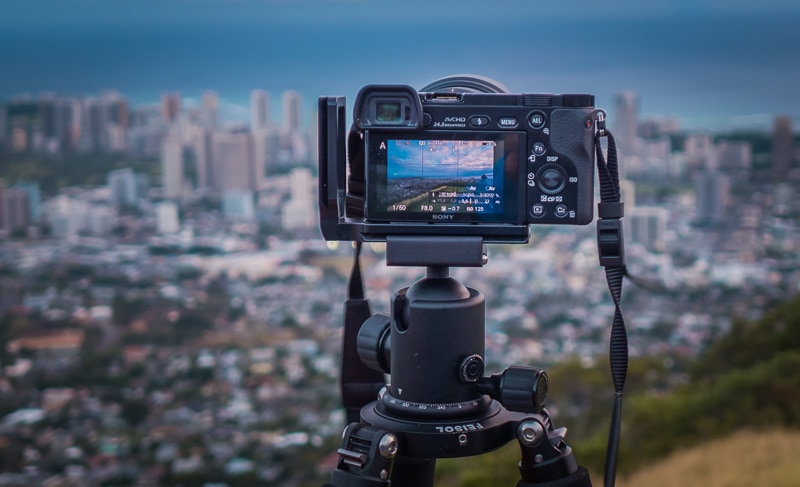
But the overlay remains useful, even once the rule itself is ingrained in your mind. The overlay can often act as a subtle reminder to position your subject slightly to the left or right, up or down – and it also just helps you visualize the precise dimensions of the rule of thirds.
So make sure it’s switched on!
Use Visual Helpers When Editing Photos
Pretty much every popular editing suite – including both Adobe Lightroom and Skylum’s Luminar – offer some sort of rule of thirds crop overlay.
So even if you fail to follow the rule of thirds when you’re out shooting…
…you can fix it pretty easily during post-processing!
It’s important to note:
You should always try your best to get the composition right in-camera.
But things happen, especially if you’re a beginner. You might forget to apply the rule of thirds. Or you might accidentally place your compositional elements slightly out of alignment with the rule of thirds.
And that’s when cropping to achieve the rule of thirds is a good idea.
Here’s how it works:

First, open your photo in a post-processing program such as Lightroom.
Access the Crop tool.
In Lightroom and Luminar, you should automatically see a rule of thirds overlay.
If the Rule of Thirds overlay is not active by default, start pressing the “O” shortcut to activate it.
Then use this overlay to guide yourself while cropping!
Easy, right?
Breaking the Rule of Thirds in Photography
The rule of thirds is a great compositional guideline.
But despite the name, it’s not a rule.
There are times when you’ll want to break the rule of thirds for an even more impactful image.
For instance, if your subject is small in the frame, you might place them below or above a horizontal gridline for a minimalistic effect.
And if your subject offers interesting symmetry, you might place them smack-dab in the center of the frame for a very intense shot.
Like this:

So while it pays to know the rule of thirds – and to always have it in the back of your mind – you should also experiment with other compositions for unique effects.
Examples of the Rule of Thirds
Now let’s take a quick look at some rule of thirds examples.
First, we have a nice landscape shot with a dramatic sky:

Notice how the horizon follows the lower gridline; this serves to emphasize the sky and deemphasize the foreground.
And here is the opposite. The colorful foreground pattern is given higher visual significance.

Then we have a portrait shot, where the subject is positioned along a vertical gridline and the eyes sit close to the rule of thirds power points:
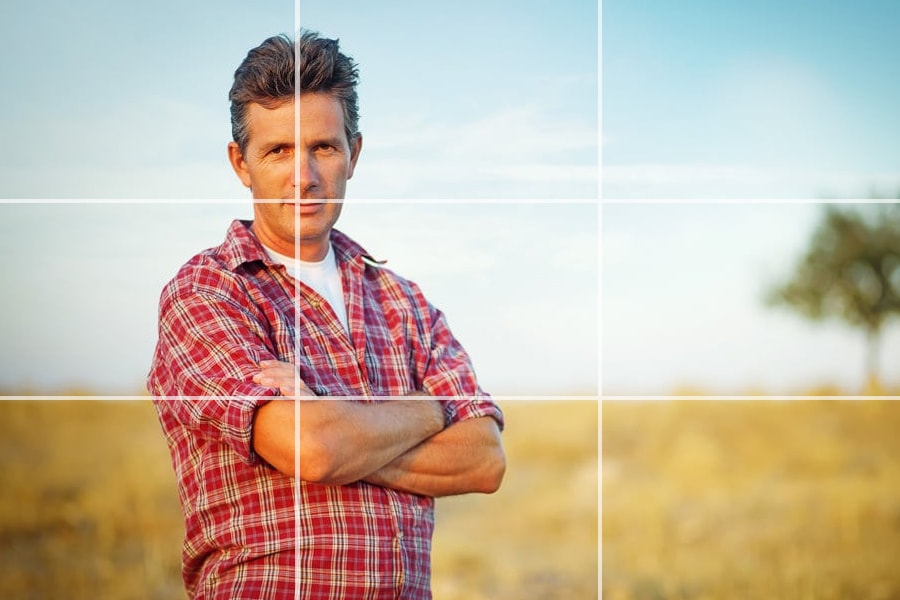
If you’re learning about the rule of thirds for the first time, I highly recommend you head over to your favorite photographer’s website. Then browse through their gallery, noting where the rule of thirds is applied, and noting how they applied it.
Because learning by example can be very powerful – and it’s a great way to get familiar with the rule of thirds, fast.
Conclusion
The rule of thirds might sound complicated, but – as you now know – it’s really not!
Just remember to turn on your rule of thirds overlay grids when capturing photos and when editing.
And don’t forget to identify your main subject before composing.
Pretty soon, you’ll be capturing stunning images like a pro!

